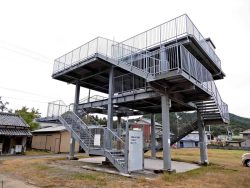
A construction worker looks up at the I-10 freeway, which was closed by fire on Nov. 19 in Los Angeles.
14:35 JST, March 9, 2024
WASHINGTON (AP) — America’s employers delivered another healthy month of hiring in February, adding a surprising 275,000 jobs and again showcasing the U.S. economy’s resilience in the face of high interest rates.
Last month’s job growth marked an increase from a revised gain of 229,000 jobs in January. At the same time, the unemployment rate ticked up two-tenths of a point in February to 3.9%. Though that was the highest rate in two years, it is still low by historic standards. And it marked the 25th straight month in which joblessness has remained below 4% — the longest such streak since the 1960s.
Yet despite sharply lower inflation, a healthy job market and a record-high stock market, many Americans say they are unhappy with the state of the economy — a sentiment that is sure to weigh on President Joe Biden’s bid for re-election. Many voters blame Biden for the surge in consumer prices that began in 2021. Though inflationary pressures have significantly eased, average prices remain about 17% above where they stood three years ago.
Friday’s report gave the inflation fighters at the Federal Reserve some encouraging news: Average hourly wages rose just 0.1% from January, the smallest monthly gain in more than two years, and 4.3% from a year earlier, less than expected. Average pay growth has been exceeding inflation for more than year, but when it rises too fast it can feed inflation.
The latest figures reflected the job market’s sustained ability to withstand the 11 rate hikes the Fed imposed in its drive against inflation, which made borrowing much costlier for households and businesses. Employers have continued to hire briskly to meet steady demand from consumers across the economy.
The February figures will likely make Fed officials more comfortable about cutting rates sometime in the coming months. With December and January job gains revised sharply down, wage growth easing and the unemployment rate up, the Fed’s policymakers aren’t likely to worry about an overheating economy. Most economists and Wall Street traders expect the first rate cut to come in June. The Fed stopped raising rates in July and has signaled that it envisions three rate cuts this year.
The unemployment rate rose last month in part because more people began looking for a job and didn’t immediately find one. The Fed could be reassured by the influx of job seekers, which typically makes it easier for businesses to fill jobs without having to significantly raise pay.
Gus Faucher, chief economist at PNC Financial Services, said he was impressed by the breadth of hiring last month: Among industries, health care companies added 67,000 jobs, government at all levels 52,000, restaurants and bars 42,000, construction companies 23,000 and retailers 19,000.
When the Fed began aggressively raising rates in March 2022 to fight the worst bout of inflation in four decades, a painful recession was widely predicted, with waves of layoffs and high unemployment. The Fed boosted its benchmark rate to the highest level in more than two decades.
Inflation has eased, more or less steadily, in response: Consumer prices in January were up just 3.1% from a year earlier — way down from a year-over-year peak of 9.1% in 2022 and edging closer to the Fed’s 2% target. Unemployment is still low. And no recession is in sight.
The combination of easing inflation and sturdy hiring is raising hopes that the Fed can achieve a so-called “soft landing” by taming inflation without causing a recession — a scenario consistent with Friday’s numbers.
Faucher said he expects average monthly job growth to decelerate to around 150,000 and for the unemployment rate to rise to slightly above 4% by year’s end. A cooling labor market, he suggested, will allow the Fed to start cutting rates this spring.
Even though the Labor Department’s revisions shaved 167,000 jobs from its previous estimate of December and January hiring, acting Labor Secretary Julie Su noted Friday that even counting those downward revisions, job growth has averaged an impressive 265,000 over the past three months.
In the meantime, many employers are still contending with labor shortages. Among them is Nicola Davies, who owns the small Tranquil Home cleaning company in San Diego and is struggling to find reliable help. Six months ago, Davies resorted to offering bonuses to employees who basically do the minimum: Show up on time and don’t provoke complaints from customers.
“That’s how horrible the climate is, ” she said.
If she has to raise wages again, she said, she might have to increase the rates she charges her cleaning customers.
At a job fair this week in Allentown, Pennsylvania, Katie Sanders, a human resources specialist, said she was seeking some machinists — “a dying breed,’’ she said — to work at Lehigh Heavy Forge, which occupies part of a former Bethlehem Steel plant and forges steel pieces for the Navy and private industries.
Sanders said it was difficult to find workers with the experience to replace those who are retiring.
“But all it takes is one,” she said, hopefully.
Hana Haseman, the human resources manager for Active Learning Centers, a chain of childcare facilities in the Allentown region, needs to fill about 10 full-time openings. The company increased wages a few years ago to as high as $20 an hour. But Haseman said raising pay is only part of the challenge.
“We have to do things internally to invest in our staff members and make them feel appreciated and let them know the work they’re doing is meaningful,” she said. “With Burger King or a warehouse or wherever paying very highly, and with the cost of our program for students and parents, being competitive is difficult.”
The tight job market means more workers have managed to find jobs that they like and that are well-suited to their skills. Some economists say that trend, along with business investment in automation, is helping fuel a surge in productivity that allows companies to raise pay and reap bigger profits without necessarily raising prices.
Consider Elizabeth Toenyes, who medically retired as an Army captain in 2022 after undergoing hip and shoulder surgeries and receiving a diagnosis of PTSD. A former public affairs office, Toenyes, 29, began seeking a job in public relations or a related field.
“It was a great time to be looking for jobs,’’ she said. “The culture of employers had begun shifting’’ as younger workers who replaced retiring baby boomers demanded more flexible working conditions, including the option to work from home.
Toenyes landed a job she loves as an editorial strategist with the staffing firm Aquent. She works from home with her service dog.
The comfortable setting makes her more productive, she said, as do artificial intelligence tools that help her write faster.
“Sometimes I can pound out a six-page blog on AI and get it done in one or two hours,’’ she said, thereby freeing up time to take a walk.
"News Services" POPULAR ARTICLE
-

American Playwright Jeremy O. Harris Arrested in Japan on Alleged Drug Smuggling
-

Japan’s Nikkei Stock Average as JGB Yields, Yen Rise on Rate-Hike Bets
-

Japan’s Nikkei Stock Average Licks Wounds after Selloff Sparked by BOJ Hike Bets (UPDATE 1)
-

Japan’s Nikkei Stock Average Buoyed by Stable Yen; SoftBank’s Slide Caps Gains (UPDATE 1)
-

Japanese Bond Yields Zoom, Stocks Slide as Rate Hike Looms
JN ACCESS RANKING
-

Tokyo Economic Security Forum to Hold Inaugural Meeting Amid Tense Global Environment
-

Keidanren Chairman Yoshinobu Tsutsui Visits Kashiwazaki-Kariwa Nuclear Power Plant; Inspects New Emergency Safety System
-

Imports of Rare Earths from China Facing Delays, May Be Caused by Deterioration of Japan-China Relations
-

University of Tokyo Professor Discusses Japanese Economic Security in Interview Ahead of Forum
-

Japan Pulls out of Vietnam Nuclear Project, Complicating Hanoi’s Power Plans


























